Triacontadigon
| Regular triacontadigon | |
|---|---|
 A regular triacontadigon | |
| Type | Regular polygon |
| Edges and vertices | 32 |
| Schläfli symbol | {32}, t{16}, tt{8}, ttt{4} |
| Coxeter diagram |
|
| Symmetry group | Dihedral (D32), order 2×32 |
| Internal angle (degrees) | 168.75° |
| Dual polygon | Self |
| Properties | Convex, cyclic, equilateral, isogonal, isotoxal |
In geometry, a triacontadigon (or triacontakaidigon) or 32-gon is a thirty-two-sided polygon. In Greek, the prefix triaconta- means 30 and di- means 2. The sum of any triacontadigon's interior angles is 5400 degrees.
An older name is tricontadoagon.[1] Another name is icosidodecagon, suggesting a (20 and 12)-gon, in parallel to the 32-faced icosidodecahedron, which has 20 triangles and 12 pentagons.[2]
Regular triacontadigon
The regular triacontadigon can be constructed as a truncated hexadecagon, t{16}, a twice-truncated octagon, tt{8}, and a thrice-truncated square. A truncated triacontadigon, t{32}, is a hexacontatetragon, {64}.
One interior angle in a regular triacontadigon is 168 1⁄4°, meaning that one exterior angle would be 11 1⁄4°.
The area of a regular triacontadigon is (with t = edge length)
and its inradius is
The circumradius of a regular triacontadigon is
Construction
As 32 = 25 (a power of two), the regular triacontadigon is a constructible polygon. It can be constructed by an edge-bisection of a regular hexadecagon.[3]
Symmetry
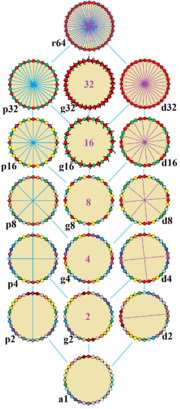 |
The symmetries of a regular triacontadigon. Lines of reflections are blue through vertices, and purple through edges. Gyrations are given as numbers in the center. Vertices are colored by their symmetry positions. |
The regular triacontadigon has Dih32 dihedral symmetry, order 64, represented by 32 lines of reflection. Dih32 has 5 dihedral subgroups: Dih16, Dih8, Dih4, Dih2 and Dih1 and 6 more cyclic symmetries: Z32, Z16, Z8, Z4, Z2, and Z1, with Zn representing π/n radian rotational symmetry.
On the regular triacontadigon, there are 17 distinct symmetries. John Conway labels these lower symmetries with a letter and order of the symmetry follows the letter.[4] He gives r64 for the full reflective symmetry, Dih16, and a1 for no symmetry. He gives d (diagonal) with mirror lines through vertices, p with mirror lines through edges (perpendicular), i with mirror lines through both vertices and edges, and g for rotational symmetry. a1 labels no symmetry.
These lower symmetries allows degrees of freedoms in defining irregular triacontadigons. Only the g32 subgroup has no degrees of freedom but can seen as directed edges.
Triacontadigram
A triacontadigram is a 32-sided star polygon. There are seven regular forms given by Schläfli symbols {32/3}, {32/5}, {32/7}, {32/9}, {32/11}, {32/13}, and {32/15}, and eight compound star figures with the same vertex configuration.
| Picture |  {32/3} |
 {32/5} |
 {32/7} |
 {32/9} |
 {32/11} |
 {32/13} |
 {32/15} |
|---|---|---|---|---|---|---|---|
| Interior angle | 146.25° | 123.75° | 101.25° | 78.75° | 56.25° | 33.75° | 11.25° |
Many isogonal triacontadigrams can also be constructed as deeper truncations of the regular hexadecagon {16} and hexadecagrams {16/3}, {16/5}, and {16/7}. These also create four quasitruncations: t{16/9} = {32/9}, t{16/11} = {32/11}, t{16/13} = {32/13}, and t{16/15} = {32/15}. Some of the isogonal triacontadigrams are depicted below as part of the aforementioned truncation sequences.[5]
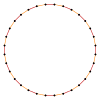 t{16} = {32} |
 |
 |
 |
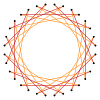 |
 |
 |
 |
 t{16/15}={32/15} |
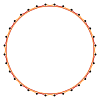 t{16/3} = {32/3} |
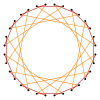 |
 |
 |
 |
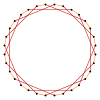 |
 |
 |
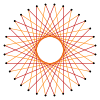 t{16/13}={32/13} |
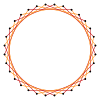 t{16/5} = {32/5} |
 |
 |
 |
 |
 |
 |
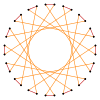 |
 t{16/11}={32/11} |
 t{16/7} = {32/7} |
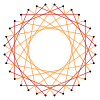 |
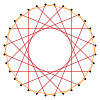 |
 |
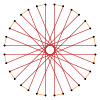 |
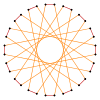 |
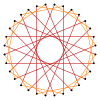 |
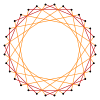 |
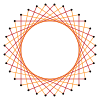 t{16/9}={32/9} |
References
- ↑ A Mathematical Solution Book Containing Systematic Solutions to Many of the Most Difficult Problems by Benjamin Franklin Finkel
- ↑ Weisstein, Eric W. "Icosidodecagon". MathWorld.
- ↑ Constructible Polygon
- ↑ John H. Conway, Heidi Burgiel, Chaim Goodman-Strauss, (2008) The Symmetries of Things, ISBN 978-1-56881-220-5 (Chapter 20, Generalized Schaefli symbols, Types of symmetry of a polygon pp. 275-278)
- ↑ The Lighter Side of Mathematics: Proceedings of the Eugène Strens Memorial Conference on Recreational Mathematics and its History, (1994), Metamorphoses of polygons, Branko Grünbaum
- Naming Polygons and Polyhedra
- CRC Concise Encyclopedia of Mathematics, Second Edition, Eric W. Weisstein icosidodecagon